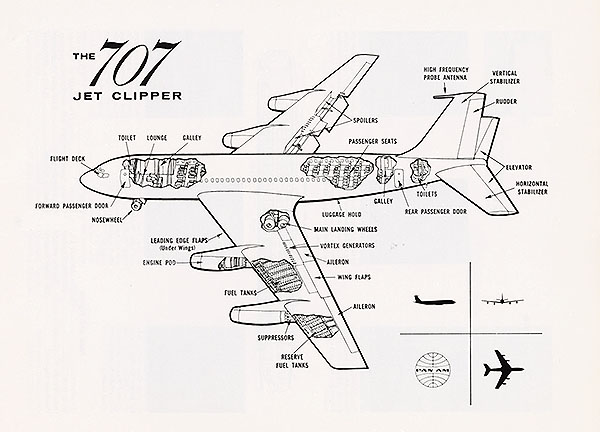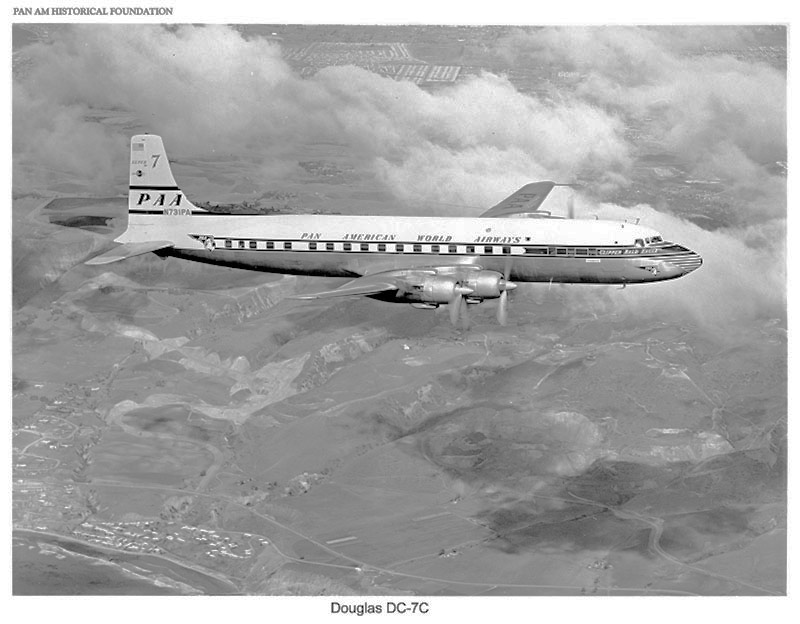OPENING THE JET AGE UNDER THE AMERICAN FLAG
Part 1
Pan Am aircraft leading up to the Boeing 707 and beyond
Words of Juan Trippe delivered July 15, 1966 for Boeing 50th Anniversary (Pan Am Historical Foundation photos).
THE AMERICAN JET AGE

The Jet Age, the wonder of aviation, did not burst into the world with flags flying and bands playing. To the contrary, it was forced upon a resisting establishment.
Entering the 1950s, airplane manufacturers did not want to build, or airlines to fly, jets. Jets were okay for the military, but commercial? They devoured enormous volumes of fuel. Civilian airports didn't have long enough runways. The capital investment was incalculable. An authoritative report by a prestigious consulting firm declared that jets could not carry the loads for long-range flight. They were perceived as a luxury for the affluent.
Britain's retirement of its jet Comet, after two crashes in less than 20 months, confirmed that the world was not ready for commercial jets. The assumption was that the next generation of airliner, to replace aging propeller transports, would be the turboprop.
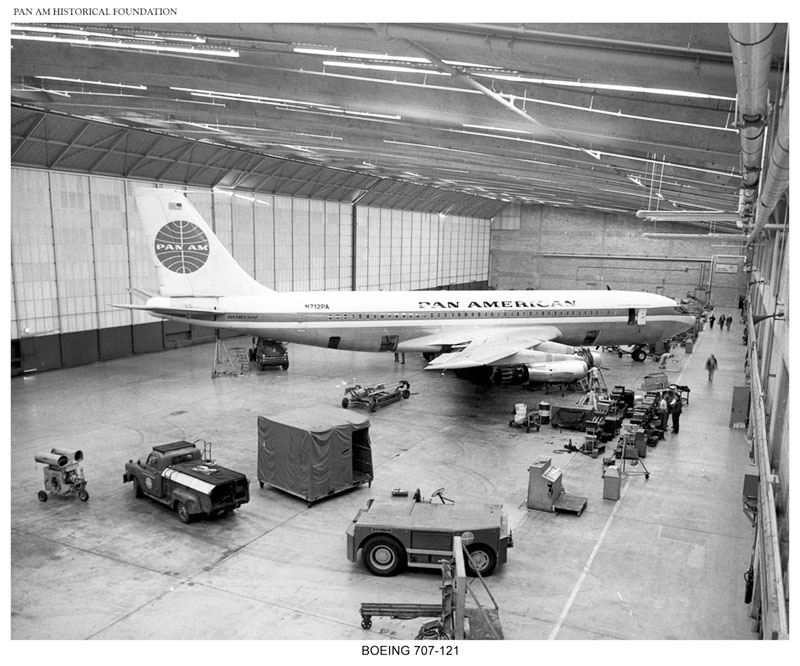
"Apart from Juan Trippe, the aviation world was terrified of jets," says Robert Daley in his book "An American Saga." The Pan Am Chairman was the only customer for jets. Nor would Trippe settle for just any jet. He demanded one that could carry nearly twice as many passengers across the Atlantic as most propeller transports, more profitably than the most profitable of them.
Douglas, Pratt & Whitney, Rolls-Royce, Boeing
Douglas, Pan Am's main supplier of aircraft, offered a jet it had on the drawing board. Boeing, then a military provider, developed a prototype of its long-range military tanker/transport which it offered to Pan Am. Pratt and Whitney offered the jet engine it had been selling to the military, but not the more powerful new one it was testing. Pan Am had determined the minimum capacity and range a jet needed to be profitable and none of these offers approached it. But despite all his cajoling, the un-eager manufacturers told Trippe, in effect, to "take it or leave it."
Then Pratt and Whitney heard that Trippe was talking jet engines to Rolls-Royce in Britain. It reconsidered and agreed to sell him 120 of its bigger engines. With the big engines in his pocket, Trippe shrugged and told Douglas that if he couldn't get the airplane he needed built in the U.S., he'd have to look overseas.
Douglas reconsidered and contracted to build 25 DC-8s to his specifications - and agreed not to disclose this. Then Trippe ordered 20 707s from Boeing.
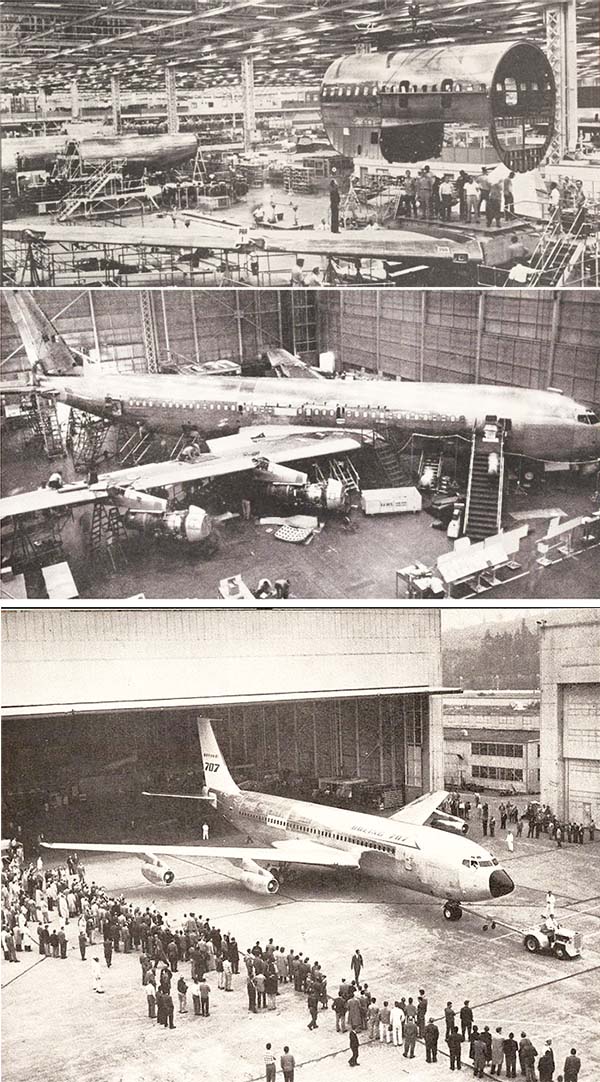
Photos: Boeing 707 under construction from "The First Boeing 707 for Pan Am" by Boeing Airplane Company (University of Miami Special Collections).
In October 1955 Trippe announced at a gathering of world airline leaders that he had just ordered 45 jets, for the then-staggering sum of $269 million. The announcement jolted the airlines and Boeing. The other airlines realized to their dismay, that to compete, they too would have to invest in jet fleets. Boeing, discovering that Douglas was building a larger jet, realized that it would have to build a competitive one and hastened to renegotiate its contract on Pan Am's terms.
Thus was world air transport catapulted unwillingly into the Jet Age - by Pan Am.
Boeing had the advantage of a flying prototype, while Douglas's DC-8 was still on the drawing board. Boeing, which before had refused to widen its 707 fuselage to accommodate six-abreast seating, now agreed to do so. (Douglas was designing a six-abreast fuselage.) Pan Am in return agreed to accept the first half dozen 707s with the smaller, 13,500 pound-thrust engines, as soon as possible, and the succeeding planes were to be more powerful.
1958 - The Pan Am Boeing 707-121 launched America and effectively the world, into the Jet Age
It was the precursor of a more powerful model, and could carry almost twice as many passengers 60% faster than the most productive prop transport, the DC-7C.
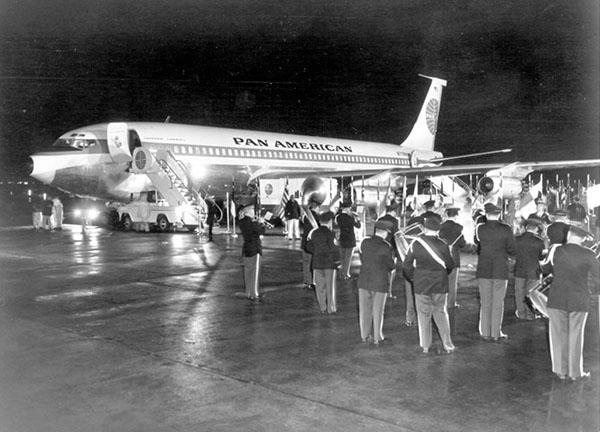
On October 26, 1958, Pan Am's 707-121 Clipper America, with 111 passengers and a crew of 11, departed New York's then-Idlewild Airport, with military bands playing and national press coverage, bound for Paris, thus inaugurating American commercial jet service. The fight took eight and a half hours, including a fuel stop at Gander.

This first model of the 707 could carry 165 passengers in all-economy class, almost twice as many passengers as the largest propeller transport, the DC-7C. It flew 555 miles an hour, cutting flying time nearly in half, and flew up to 32,000 feet, frequently above the weather. With its speed and capacity, the 707 did three times the work of the DC-7C; on the other hand, it needed two miles of runway to take off and had to inject water into the engines to generate enough thrust. Nor was its range as long as the DC-7C. But these handicaps did not last long.
1959 - The -321 Series of the Boeing 707
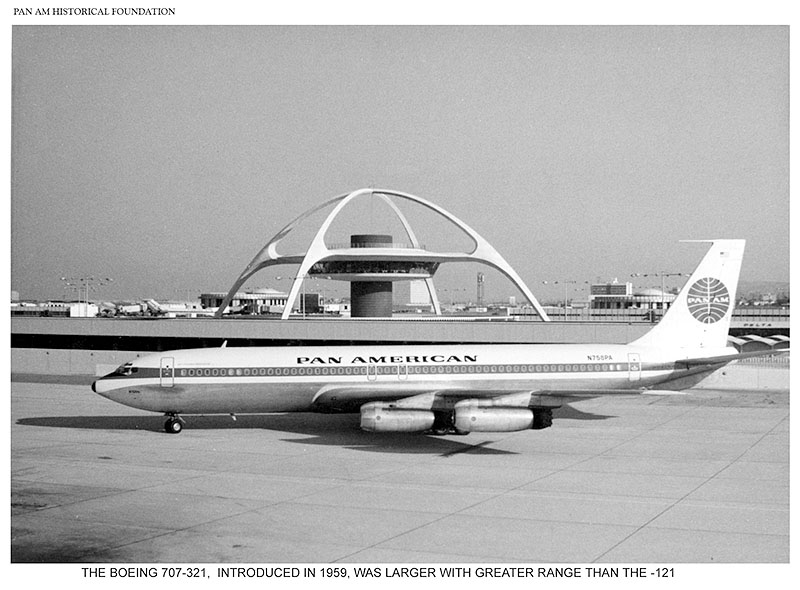
The -321 series of 707s, equipped with the more powerful engines that Trippe had pried out of Pratt and Whitney, started arriving in mid-1959. The 15,800 pound-thrust JT-4 engines boosted the 707's weight-lifting ability from 129 to 156 tons and extended its range from 3,200 to 3,900 miles. Pan Am jets could now fly routinely from New York as far as Frankfurt, Rome or Rio de Janeiro nonstop.
In the first two years after it introduced jets, Pan Am accomplished the transition from propellers to jets over its worldwide routes: to Europe and Africa, the Caribbean, Central and South America, Australasia, the Middle East.
The 1960 annual report proudly announced "the free world has become a neighborhood."
1960 - The Douglas DC-8-32
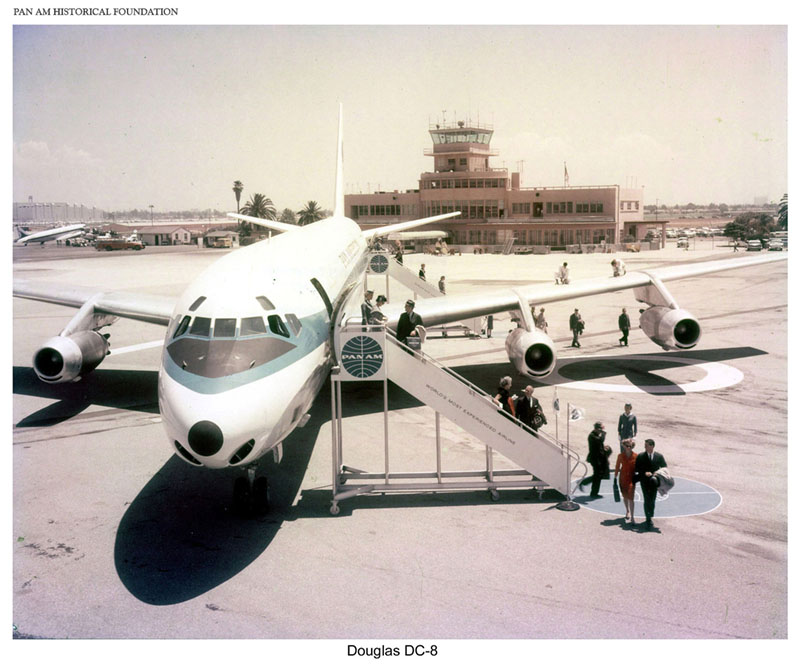
Douglas began delivering DC-8s to Pan Am early in 1960, and they entered service in the spring. Their performance was very similar to the 707-321s; they had slightly more speed and slightly less range. Pan Am's Boeings had been flying for 16 months before the Douglas jets came on line, however, and had stolen the march. Pan Am ended up taking delivery of 19 of the 25 DC-8s and operated them for about ten years. DC-8s flew beside the Boeings 'til the end of the '60s, when Pan Am sold them. Pan Am's affiliated airlines, Panagra and Panair do Brasil, also flew DC-8s.

Panagra "sky card" featuring their Douglas DC-8 Airliner (Courtesy of Florida Memory, State Library and Archives of Florida, Digitized Loans Collection).
BUT FOR BOLD INNOVATION, NONE RIVAL PAN AM'S ORDERS CREATING THE 707 OR THE 747 AND THRUSTING WORLD AVIATION INTO THE JET AGE.
-- Article adapted from the Pan Am Historical Foundation annual calendar, 1998
Related Articles:

